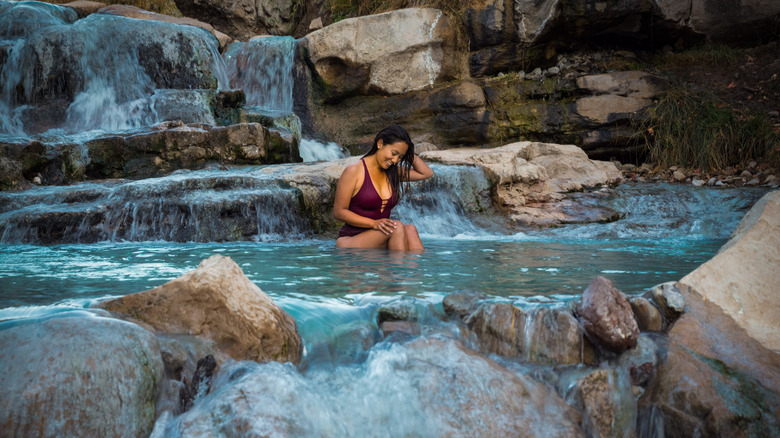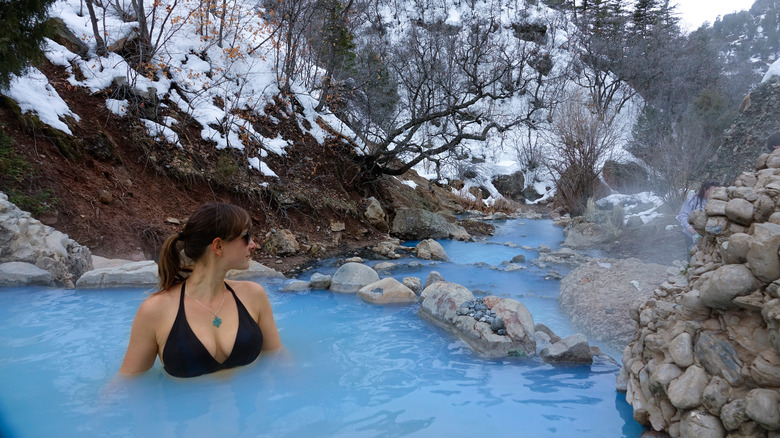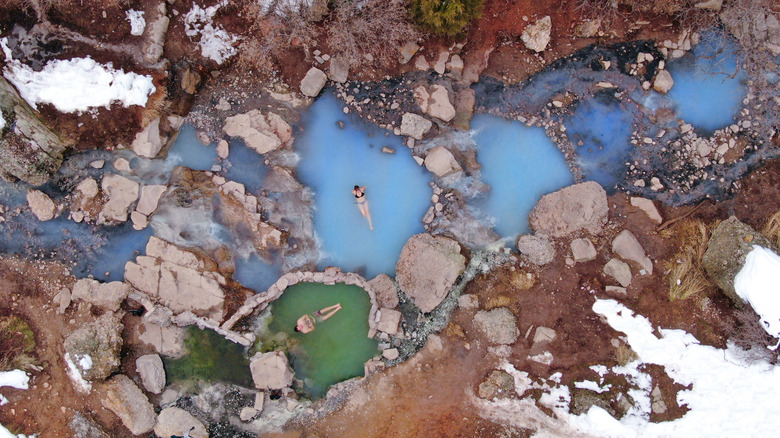Imagine trudging through a forest in a scenic canyon. While this isn’t a difficult hike, you feel a slight burn in your legs and lungs, indicating you’ve covered some distance, probably a few miles. Suddenly, you notice the water in a nearby creek has taken on a milky turquoise color, and the air smells slightly sulfuric. All at once, the forest opens up to reveal a series of bright blue and green pools, some of which sit at the base of picturesque waterfalls. Have you been catapulted into a fairy tale? Nope — this place is real.
You’ve just arrived at one of the best places to soak in all of Utah, the Fifth Water Hot Springs (also known as Diamond Fork Hot Springs), about 30 miles southeast of Provo, Utah. This popular spot can be reached via the aptly named Fifth Water Hot Springs Trail #015, which travels through a section of the Uinta-Wasatch-Cache National Forest. The moderate 4.5-mile out-and-back hike has about 630 feet of elevation gain, just enough to appreciate a steamy bath. Other than their otherworldly beauty, the other great thing about these springs is that the pools have slightly different temperatures. This means you can choose the one that’s right for you or hop from pool to pool if you so desire.
The hike to the springs

To reach the Fifth Water Hot Springs trailhead, start from the city of Spanish Fork and drive east for around 10 miles on Highway 6 to the Diamond Fork turnoff. Take Diamond Fork Road for another 10 miles to the trailhead parking lot, which will be on your left. If the small parking lot is full, you can backtrack on the road you came in on and park at the gate. However, this will add another 3 miles (round trip) to your hike. To avoid a longer hike, arrive at the trailhead nice and early. There’s a pit toilet at the trailhead but no facilities further on, so do what you need to do before you get going.
Once on the trail, you’ll cross the Diamond Fork River. Then, the well-maintained route follows the north side of Sixth Water Creek as you head east into the canyon. After about 1 mile at the stream and trail fork, take the bridge over the stream and follow the path on your right. This trail runs parallel to Fifth Water Creek, which is a smaller stream. Shortly after you begin to smell sulfur, you’ll see the main pools at the base of a waterfall. A second higher-up waterfall is even more striking than the first one, with a series of pools between the two cascades. Little rock walls separate the pools, creating areas for people to soak in.
Insider tips and information

We’ve compiled some information to help you maximize your thermal adventure. First, know that you can visit this area year-round, including in winter, when the snowy surroundings make soaking even more surreal. But the last part of the road to the trailhead is closed to vehicles in winter. This means you’ll have to park at the gate described earlier, making your hike a bit longer. If you have questions about road closures, contact the Spanish Fork Ranger District.
When hiking in winter, bring enough warm clothes for the longer hike, including a beanie and some gloves. Your destination may be hot, but the journey to get there most likely won’t be. Microspikes can also be helpful in winter to keep you from slipping on the icy trail and falling into the creek — unless, of course, you enjoy very cold plunges. No matter what time of year you’re hiking, always bring plenty of water to avoid dehydration. Don’t drink the water in the springs or let it get into your mouth or nose, as it may contain bacteria or algae.
In addition, bring sandals or water shoes to protect your feet from sharp rocks when moving in and around the pools. Finally, there are no trash cans at the springs, so do nature and other visitors a favor and “leave no trace,” that is, pack out all your garbage. If you need a reminder, here’s a quick guide to the all-important Leave No Trace Principles.

